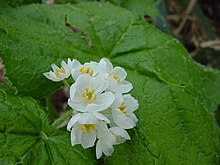Diphylleia grayi, the skeleton flower, is a species of perennial plant in the family Berberidaceae. It is native to northern and central Japan.[2]
| Skeleton flower | |
|---|---|

| |
| Scientific classification | |
| Kingdom: | Plantae |
| Clade: | Tracheophytes |
| Clade: | Angiosperms |
| Clade: | Eudicots |
| Order: | Ranunculales |
| Family: | Berberidaceae |
| Genus: | Diphylleia |
| Species: | D. grayi
|
| Binomial name | |
| Diphylleia grayi | |
Description
editThe plant grows up to 0.4 m (1.3 ft). The flowers are white, pedicellate, with six obovate petals and bloom from May to July.[3] After it flowers, it bears dark blue/purple fruit with a white powdery coating from June to August.[4] Its stems are terete and grow 30–60 cm (12–24 in) long. Its rhizomes are stout and knotty. The plant is known to have petals that become transparent when in contact with water, giving it its common name. Once it is dry, the petals return to white.[5]
Distribution and habitat
editThe plant is distributed from north to central Honshu, Hokkaido, Mount Daisen, and Sakhalin. It grows in slightly moist places in the woods of high mountains.[6][7]
Medical uses
editIn the 1960s, botanist Yanagi Kimura discovered that D. grayi crude extracts contain substances similar to, but more powerful than podophyllin and colchicine. The extract had anti-tumor effects on transplantable animal tumors.[8]
Gallery
edit-
Fruit
-
Young fruits
-
Flowers
-
Bud
See also
editReferences
edit- ^ "Diphylleia grayi F.Schmidt — The Plant List". The Plant List. Retrieved 23 November 2021.
- ^ "Diphylleia grayi F. Schmidt". Encyclopedia of Life. Archived from the original on 2019-04-22. Retrieved 23 November 2021.
- ^ "Diphylleia grayi - F.Schmidt". Plants for a Future. Archived from the original on 2016-04-17. Retrieved 7 January 2022.
- ^ Citizen science observations for Diphylleia grayi at iNaturalist
- ^ "Skeleton Flower". Our Breathing Planet. Archived from the original on 2015-05-25. Retrieved 7 January 2022.
- ^ 日本の高山植物. 山溪カラー名鑑. Yamakei. 1988. p. 431. ISBN 4635090191.
- ^ Ohwi, Jisaburo (1965). Flora of Japan. Washington: Smithsonian Institution. p. 464. doi:10.5962/bhl.title.43786. LCCN 65062683. OCLC 182709297.
- ^ Yamamoto, Kohtaro; Kimura, Yanagi (December 1964). "Cytological Effects of Chemicals on Tumors, XXV. : Further Studies on the Effect of Diphylleia grayi Extracts on Tumor Cells (With 2 Text-figures and 2 Tables)". 北海道大學理學部紀要. 15 (3). 北海道大學: 347–352.